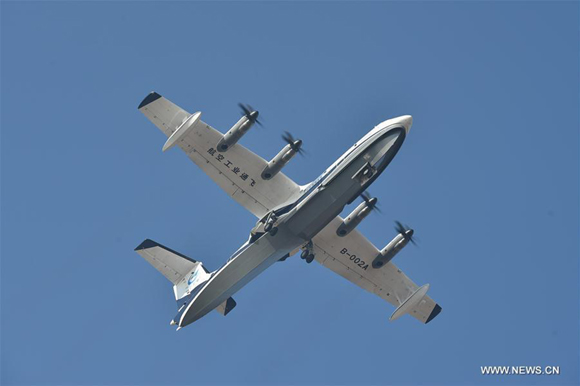
China's first home-grown large amphibious aircraft AG600 takes off at the Jinwan Civil Aviation Airport in Zhuhai, south China's Guangdong Province, Dec. 24, 2017. (Xinhua/Liang Xu)
China's first home-grown amphibious aircraft, the AG600, completed its maiden flight in Zhuhai, south China's Guangdong Province, on Sunday.
It is a major piece of aviation equipment in China's expanding emergency rescue system and a milestone in the country's amphibious aircraft development.
The Communist Party of China (CPC) Central Committee and the State Council congratulated all those involved in the mission, including those from the Ministry of Industry and Information, the Civil Aviation Administration of China and the Aviation Industry Corporation of China.
Codenamed "Kunlong", the plane was designed to be the largest amphibious aircraft in the world. It is 36.9 meters long, 12.1 meters tall and has a wingspan of 38.8 meters.
According to its developer, the Aviation Industry Corporation of China (AVIC), the aircraft has a maximum take-off weight of 53.5 tonnes and a top cruising speed of 500 kilometers per hour, and a maximum flight range of 4,500 kilometers.
The chief designer of the AG600, Huang Lingcai, was quoted in China Daily earlier this month as saying the aircraft can make round trips from the southern island province of Hainan to James Shoal without needing to refuel.
The four-engine amphibious aircraft was developed for two main purposes: extinguishing wildfires and maritime rescue.
The ideal fire extinguisher and maritime rescuer
With a capacity to carry 50 people during search-and-rescue missions, the AG600 can collect 12 tons of water within 20 seconds, and extinguish a fire area of over 4,000 square meters with one spray.
The capability of being able to take off and land on water makes the AG600 efficient for maritime rescues.
With top cruising speeds of 500 kilometers per hour – over 10 times that of a salvage ship – and a flight time of up to 12 hours, the plane has the endurance to carry out rescue operations under extreme meteorological conditions, and resist two-meter-high waves.
Its maximum rescue operation radius extends to 1,600 kilometers, which could cover most of China's sea areas and exclusive economic zones.
Huang said that besides these two main applications, the AG600 can also be used in tourism as the high cruising speed and large flight range would allow the aircraft to work as an "airbus", carrying tourists between airports and islands.
A work of indigenous innovation
The AG600 is the third member of China's "large aircraft family" after the large freighter Y-20 and large passenger aircraft C919. /Photo via VCG
The AG600 is considered to be a work of indigenous innovation because the aircraft consists of more than 50,000 components and 98 percent of them were provided by domestic suppliers. Moreover, 95 percent of the onboard products were made in China.
Zhao Peng, the director of the maiden flight - who has also participated in the test flights of the large C919 passenger jet - told CCTV that besides China, the only countries that have the ability to develop amphibious aircraft are Russia, Japan, and Germany.
The AG600 is the third member of China's "large aircraft family" following the development of the Y-20 freighter and C919 passenger aircraft, which made their maiden flights in 2013 and 2017 respectively. The Y-20 entered into service with China's air force in July 2016.
Key to success
During an interview with CCTV, Zhao mentioned three key points that made the maiden flight successful.
"First of all, we must be sure of the basic structure of the plane. Second, the plane weighs 50 tons, so the engines must function well. The third point is how the plane operates. If the plane catches fire and starts smoking, or suffers structural damage after take-off, we will take effective landing and conduct a rescue mission on the ground."
Zhao said that the success of the test flight on land only represents half of the AG600's maiden flight mission. "We usually do maiden water flights in big reservoirs, and the best time is between May and August, so we plan to do it next summer."


















































